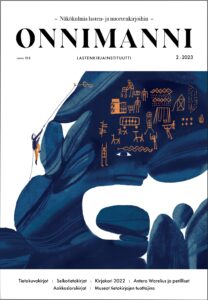
This issue of Onnimanni is a special number dedicated to non-fiction for young readers, which has received financial support from The Association of Finnish Nonfiction Writers.
During the 21st century, non-fiction for children and young adults has diversified its range of topics and the number of titles published has increased. A general trend within Finnish non-fiction is to focus more exclusively on a particular subject, such as e.g. money, crime and its effects, concrete, brain physiology or energy. Apart from children’s and YA authors, experts and researchers within various fields write non-fiction.
Pictures have become increasingly important in non-fiction books. Pirita Tolvanen has visited the Bologna Children’s Book Fair and seen the exhibition Beauty and the World curated by Giorgia Grilli and Ilaria Dindelli. Tolvanen notes that the exhibition introduced “new non-fiction picturebooks” which focus especially on visuality and experience. She also concludes that the Finnish book market needs more non-fiction sub-categories.
Tuula Korolainen presents the latest children’s non-fiction books published by museums. These books elaborate, for example, on the contents of a current exhibition or present museum services or art history in a broader sense.
Non-fiction in plain language has lately become more common in Finland and the range of such books for young readers has gradually increased. Mervi Heikkilä lacks, however, common rules for how to write and illustrate non-fiction in plain language. In order to meet the demands of writing, illustrating and publishing plain language non-fiction books, Heikkilä declares that more financial support is needed.
Antero Warelius (1821–1904) wrote the first Finnish non-fiction children’s book in 1845. Warelius’ book teaches children about nature by featuring a child and an adult discussing natural phenomena. Kari Vaijärvi shows how Warelius’ modern combination of fact and fiction into “faction” is still a prominent trait in award-winning Finnish non-fiction for children today.
The Institute’s bibliography of illustrators offers a cross-section of Finnish children’s book art since 1847. Päivi Nordling’s article presents contemporary Finnish illustrators who were mainly born between the 1950s and 1990s. Figure 1 shows how the number of illustrated titles for young people has changed since 1847. Figure 2 displays the increase in illustrated titles during 2000–2021.
Poetry picturebooks, which teach readers the alphabet, has a long tradition within children’s literature. Illustrators and artists have always taken an interest in the graphic form of letters. Päivi Heikkilä-Halttunen’s article explores the foreign and domestic history of alphabet picturebooks. She concludes e.g. that in some of the latest Finnish books, the visual aesthetics have in part supplanted previously important pedagogic ambitions.
Kaisa Laaksonen observes that the Institute’s annual Kirjakori-survey – which overviews Finnish books published for children and teenagers in 2022 – shows that picturebooks have become increasingly difficult to separate from non-fiction books, since contemporary picturebooks also contain plenty of facts. The recent Kirjakori-exhibition includes 214 non-fiction books published in 2022, of which 127 are Finnish originals. A survey of the contents of the Kirjakori 2022-exhibition is available in English on the Institute’s web pages.
The Puntari-section of Onnimanni features reviews of the latest, most interesting Finnish original and translated non-fiction books for young readers.
Translation Maria Lassén-Seger
